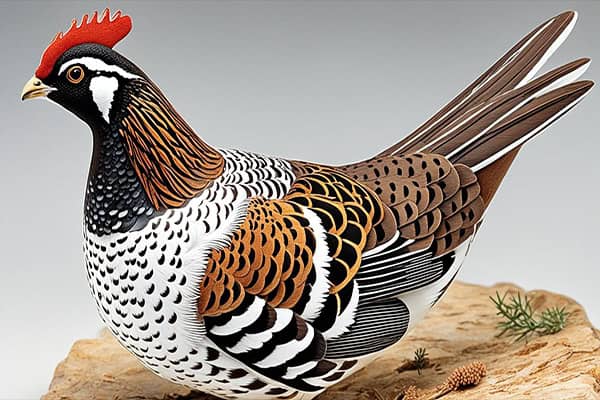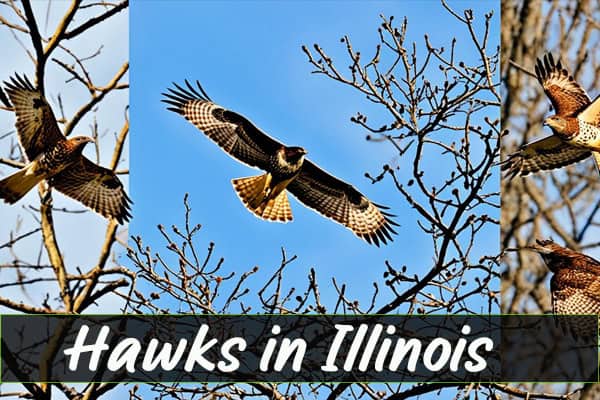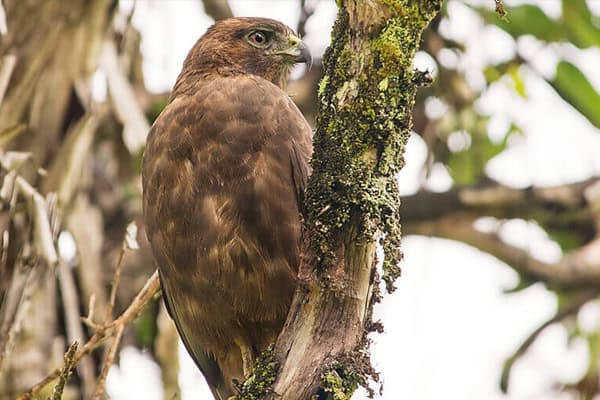What Does a Grouse Look Like: Appearance and Features
Have you ever wanted to know more about the mysterious grouse or What Does a Grouse Look Like? These birds are medium-sized, with a short crest. They can be hard to see in the forest because of their great camo. Their feathers are patterned in grayish brown to reddish brown, perfect for staying hidden.
But, grouse are not just any bird. They show off with a striking black “ruff” and tail feather displays. Some, like the Ruffed Grouse, create tiny sonic booms when showing off. These birds, though usually shy, might get close to people who are interested in them.
Grouse stands out with their unique feathers and actions. They have a peaked crest, a bright line around their eyes, and a dark tail tip. These details help us tell the different grouse kinds apart. For those who love watching birds, understanding grouse is a fun challenge.
What other secrets do grouse have? How do they survive in their environment? Let’s explore the fascinating world of grouse and find out more about these amazing birds.
Introduction to Grouse
Grouse are a type of game bird found in North America. They differ in size, color, and patterns. Each type is shaped by its home, helping it to live well in its environment. The Ruffed Grouse and the Spruce Grouse are some of the most popular ones.
Types of Grouse
Ruffed Grouse live in many places across North America. They are present in all Canadian provinces and in 38 states in the U.S. Their lives range from Labrador down to northern Georgia. They can also be found in a few spots in both Dakotas.

On the west side of the continent, their habitat extends to central Wyoming and Utah. Spruce Grouse, or Franklin’s Grouse, prefers the cooler forests. They are commonly found in areas with spruce, jack pine, and lodgepole pine in Oregon, Washington, Alaska, and Canada. They love the dense cover of the forests in the north and west.
Habitat and Range
Ruffed Grouse makes homes in mixed forests. These forests have both deciduous and evergreen trees. They are often found near clearings and streams. Their camouflage makes them hard to see.
Spruce Grouse prefers thick, evergreen forests. They choose places with plenty of spruce, jack pine, and lodgepole pine. Knowing about the different kinds of grouse and where they live is helpful for bird watchers, hunters, and those working to protect them.
Size and Shape
The Ruffed Grouse and the Spruce Grouse differ in size and shape. Ruffed Grouse are small with a short, triangular crest and a long tail. They look slim, akin to an American Crow but smaller than a Wild Turkey.
Ruffed Grouse Size and Shape
Ruffed Grouse are small and slender. They sport a short crest and a tail meant for display. Their size and build place them lower to the ground.
Spruce Grouse Size and Shape
Spruce Grouse stands out as stout, resembling a chicken. They have a small bill, short, thick legs, and a medium tail. Their size is similar to a crow in comparison to other birds.
Color Pattern and Plumage
The unique grouse plumage is vital for their ability to blend in and their recognition. Now, we will focus on the color patterns of two major grouse species in North America – the Ruffed Grouse and the Spruce Grouse.
Ruffed Grouse Color Pattern
Ruffed Grouse features detailed ruffed grouse plumage, displaying dark lines and spots on a red-brown or gray base. The dark lines on the neck lead to wider bars on the belly. Also, the ruffed grouse tail has fine bars and a broad, black band towards the tip. In most areas where they live, Ruffed Grouse show various grouse color variations. They might have mostly gray or red-brown body feathers. Their tails also vary in color.
Spruce Grouse Color Pattern
Spruce grouse females appear in two specific color morphs: gray and chestnut, with strong bars on their bellies. The male Spruce Grouse, on the other hand, has a slate gray head and neck. It features a red eyebrow and a black chest. Plus, white markings can be found on its lower belly. The spruce grouse tail may be dark or have a chestnut tip, depending on where they are found.
Variations in Color Phases
Ruffed and Spruce Grouse can show grouse color variations in different areas. And knowing these variations helps us identify and enjoy the beauty of these interesting birds.
What Does a Grouse Look Like
Grouse are medium-sized game birds with short crests and well-camouflaged plumage. They have intricately barred and spotted feathers, making them stand out. These birds also have long neck feathers that can stand up into a “ruff” and fan-shaped tails. When looking at them, you’ll find the males a bit bigger than the females.
Distinctive Features of Grouse
Distinguishing between male and female grouse is interesting. You can look at the length of their tail feathers to guess their sex. Generally, males have longer tails. Male grouse also have a more noticeable neck Ruff. They perform unique displays, like the “drumming” of the Ruffed Grouse.
Differences in Male and Female Appearance
Although male and female grouse are alike in some ways, they have clear differences. Males are a bit larger and have more striking features, such as longer neck feathers and tails. In contrast, females have less noticeable plumage. This helps them stay hidden in the forest when taking care of their young.
Behavior and Displays
Grouse show amazing grouse behavior and grouse displays. A big part of this is the Ruffed Grouse’s male “drumming” show. He stands on a log and quickly hits his wings. This makes a unique drumming noise. The male does this to claim his area and find a partner.

Drumming Behavior of Ruffed Grouse
The drumming sound can be heard far away, up to a quarter mile. The quick wing beats create this sound. It’s like many small sonic booms. The male picks a spot everyone can see. Then he does his drumming to let the females know he’s there and ready to mate.
Courtship and Nesting Behavior
Courtship is quick for grouse, just a few minutes. The female, or hen, then goes off to the nest. The nest can be over half a mile from the drumming spot. Nests are usually under leaves near a tree. They hold 8 to 14 eggs. The chicks leave soon after hatching. They can travel far and will meet up with the hen later.
Identification and Distinguishing Characteristics
Examining the length and patterns of grouse‘s tail feathers is a key way to tell them apart. Typically, males have longer tails than females. So, if a bird has tail feathers longer than 5-7/8 inches, it’s likely a male. If shorter than 5-1/2 inches, it’s probably a female. Also, looking at the tail’s color and pattern can help. For instance, a Ruffed Grouse has a wide, black band near the tip. Spruce Grouse tail feathers show different patterns and colors by region.
Tail Length and Feather Patterns
Male and female grouse can be spotted by the presence of whitish spots on the male’s upper rump. These unique indicators and tail designs are vital for grouse species identification.
Regional Variations
In different areas, grouse can look and act differently. Take the “Franklin’s” Spruce Grouse, for example. It doesn’t have the reddish tail tips that the “Canada” type does. It also differs in feather patterns, behavior, and even genetics. Knowing about these regional variations helps in identifying grouse correctly.
Check Our Previous Articles:
Grouse in Different Seasons
We see grouse change as the seasons pass. In winter, the Ruffed Grouse changes a lot to cope with the cold and snow. This shows how amazing nature is.
Winter Plumage and Feeding Habits
When it gets cold and snows, the Ruffed Grouse turns more gray to match the snow. They feed on tree buds and catkins. Trees like aspens, birches, and cherries are where they find their food. This helps them survive the tough winter.
Summer Appearance and Broods
In summer, grouse look different. Their feathers are greener, like the summer leaves. They eat leaves, fruits, and bugs. This diet is richer and more varied than in winter. Grouse mothers are busy looking after their chicks, which quickly start moving and flying.
Conclusion
Grouse are amazing game birds that live in forests across North America. The Ruffed Grouse has a hidden look and shows off in unique ways. The Spruce Grouse has its own style in different areas. They all keep us interested in their special traits.
Learning about grouse helps us see how tough and able they are. We notice their drumming, and nests, and maybe see them outdoors. Grouse makes us feel close to nature with their magic.
We, who love birds and the outdoors, can learn more about grouse and help protect them. The Ruffed Grouse Society, supported by Mark Parman for over 20 years, works to keep these birds thriving for the future.






